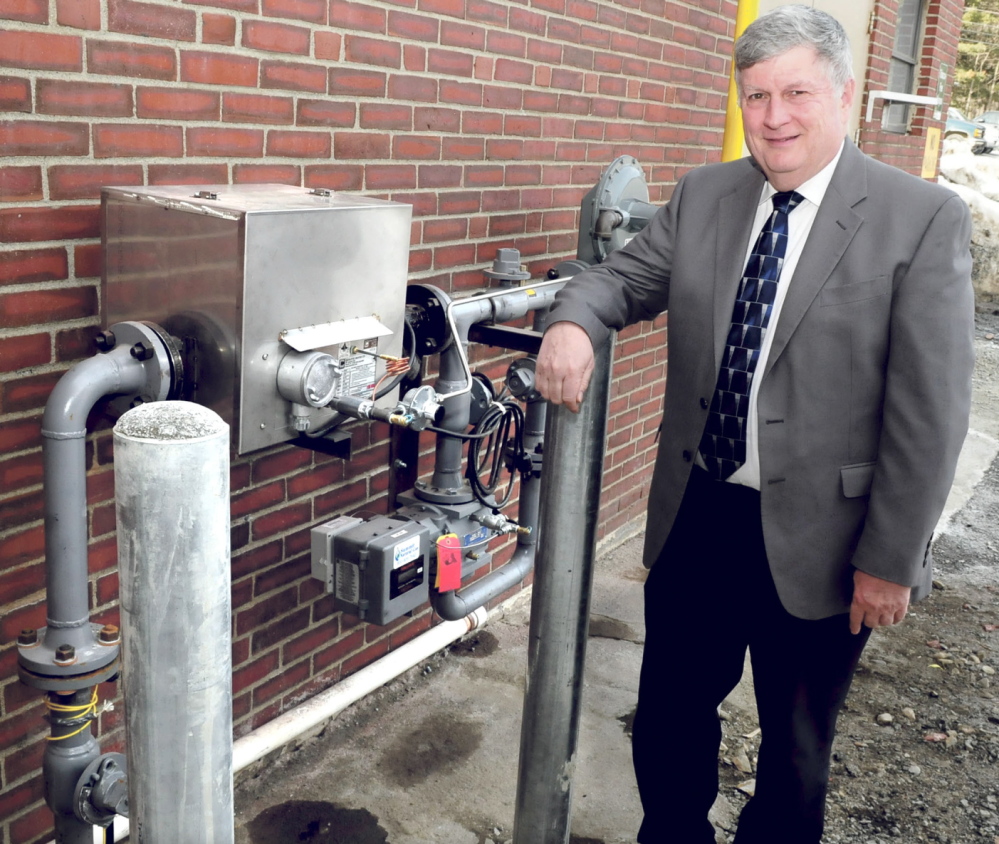WATERVILLE — Inland Hospital is the city’s first commercial customer of a new natural gas pipeline running through the region, a sign that thousands of Waterville residents will soon be able to follow suit.
“Step back and look at the larger picture here, which is that this is huge for the economic development of the area,” John Dalton, president and CEO of Inland, said after the development was announced Monday.
For the area’s major businesses, Dalton said the pipeline will erase a competitive disadvantage that has existed for years. He said Inland, which is expected to save between $100,000 and $150,000 each year in energy costs, will be able to better compete with hospitals in Augusta, Bangor and Lewiston, while the region’s paper mills will be able to reduce their costs as well.
Summit Natural Gas President Mike Minkos issued a statement in which he referred to Inland as an anchor customer whose transition to natural gas is a “major milestone” in the Kennebec Valley project. Summit is competing for customers with Maine Natural Gas, another company that provides gas to most of the state buildings in the Augusta area.
Other anchor customers in the region that have already signed contracts with Summit include Thomas College and Huhtamaki in Waterville; the city of Augusta; Sappi Fine Paper, Skowhegan Savings and Redington-Fairview General Hospital in Skowhegan; and UPM Madison. Thomas College is expected to announce its conversion this week.
Michael Duguay, business development director for Summit and a Waterville resident, said the pipeline’s extension in the local community has personal meaning to him.
“If each family can save between $1,000 and $1,500 themselves, that goes into the local economy for restaurants, clothing, car repair and other things that are the basis of the economy,” Duguay said. “This is big. It really is big.”
Inland has three boilers in its basement. Now only one is actually using gas, but the other two will come online over the next couple of weeks, allowing the hospital to pay back its conversion costs in about 14 months, according to Dalton.
“Once we saw the numbers, it was a no-brainer,” he said.
Dalton said the savings were just one part of Inland’s annual operating budget, estimated at between $60 and $70 million, but that it helps the hospital to provide more robust services and staffing levels.
“This money goes into our operating budget,” he said. “This is money we can spend on staff, can spend on services that we’re not spending on No. 2 oil.”
Dalton said the 48-bed hospital had the option to truck in natural gas, but waited because it wanted to provide added incentive to Summit to bring natural gas to the city.
“Did it have any effect or not? We don’t know,” Dalton said. “But we said from the beginning that we would hold off to see what direction the community was going to go in.”
Dalton said Inland is also mindful of the environmental benefits created with the switch to a cleaner-burning fuel. The hospital boiler system will retain the ability to burn oil, and Dalton said it probably will burn oil once per year to keep that capability as a hedge against the ever-uncertain future of energy markets.
With Summit estimating that residential customers can save up to 50 percent on their heating costs, area residents have been awaiting word as to when they too might be able to switch to natural gas.
This portion of the $460 million pipeline project has involved hiring more than 700 workers to build 68 miles of steel main pipeline and 1,500 miles of distribution pipeline in the area between Augusta and Madison.
Duguay said about 1,200 customers in Augusta, Gardiner, Hallowell and Waterville are actually using the service right now. Many of those customers are businesses, such as Inland, but a majority are residents.
During 2014, Duguay said the build-out would bring service to 1,500 people in Waterville, with a similar number being added each year for the next several years.
Phase one includes taking the service further north along the Kennebec Valley to communities like Pittsfield all the way up to Skowhegan. Other communities, including Oakland, aren’t expected to receive service until next year.
In each community the pipeline hits, Duguay said commercial strips like Waterville’s Kennedy Memorial Drive are acting as the “backbone” of the infrastructure, concentrated pockets of heavy usage from which smaller pipes can be built out.
“We’re now pushing pipes into residential neighborhoods,” he said. “You can’t do it the other way around.”
For the most part, the residential customers who will get service first are those who live along the path of the main pipe. Early examples in Waterville are those who live on West River Road or College Avenue.
In all, the number of residents who receive service this year will outnumber commercial customers 10 to 1, Duguay said.
By the end of the building phase, he said, 80 percent of Waterville’s customers, which would be about 12,500 people, will have access to gas from the pipeline.
Duguay said talks with the University of Maine at Farmington are ongoing, and that both parties expect to come to a formal agreement in the spring that would allow for the pipeline to be extended into Franklin County.
Matt Hongoltz-Hetling — 861-9287 mhhetling@centralmaine.com Twitter: @hh_matt
Send questions/comments to the editors.



Success. Please wait for the page to reload. If the page does not reload within 5 seconds, please refresh the page.
Enter your email and password to access comments.
Hi, to comment on stories you must . This profile is in addition to your subscription and website login.
Already have a commenting profile? .
Invalid username/password.
Please check your email to confirm and complete your registration.
Only subscribers are eligible to post comments. Please subscribe or login first for digital access. Here’s why.
Use the form below to reset your password. When you've submitted your account email, we will send an email with a reset code.